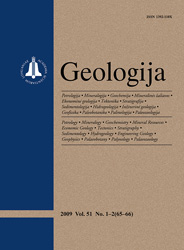Geologija / Geology
WHAT?
 ISSN 1392-110X ISSN 2029-056X (online) |
2008 m. Nr. 3 Differences of Vilnius topsoil contamination in the Neris River valley due to anthropogenic factors
The differences among topsoil contamination by Zn, Pb, Cu, Sn, Ag, Mo and Ni in various groups and subgroups of 82 sites within the central districts of Vilnius located in the Neris River valley are analysed explaining them by the influence of various anthropogenic factors. These chemical elements are the main contaminants of the study area among 13 elements, the total contents of which have been determined in fraction <1 mm by optical atomic emission spectrophotometry. The territory is rather homogeneous according to natural factors. The general anthropogenic factor of the three main types of land-use has the greatest influence on urban topsoil contamination. In infrastructural-industrial sites, which are influenced by direct anthropogenic factors, the concentration coefficients of most of the main contaminants (Pb, Cu, Mo, Ni) are significantly higher than in residential and public-residential groups in which the role of such indirect anthropogenic factor as density of built-up areas, as well as of the general factor of time-span of urbanisation increases. In the infrastructural-industrial group, present or former industry is the main direct factor, followed by parking or repair of transport and the latter followed by main traffic roads. In the residential and public-residential group, the main variability of contamination is related to the time-span of urbanisation with an increase of Ag, Zn and Cu as the time-span of urbanisation grows. For the factor of density of built-up areas, no significant differences were found, probably because of a simultaneous influence of other anthropogenic factors. The differences between public-residential and residential sites are mostly insignificant, indicating similarity of population exposure. In public-residential sites, a higher contamination by Ag is characteristic of public health care sites and by Sn of public business sites.
Keywords: urban soil, contamination, hazardous chemical elements, anthropogenic factors |
Issues:
2011 - Vol.53 No. 1, No. 2, No. 3 2010 - Vol.52 No. 1-4 2009 - Vol.51 No. 1-2, No. 3-4 2008 - Vol.50 No. 1, No. 2, No. 3, No. 4, No. Priedas 2007 No. 1, No. 2, No. 3, No. 4 2006 No. 1, No. 2, No. 3, No. 4 2005 No. 1, No. 2, No. 3, No. 4 2004 No. 1, No. 2, No. 3, No. 4 2003 No. 1, No. 2, No. 3, No. 4 2002 No. 1, No. 2, No. 3, No. 4 2001 No. 1, No. 2, No. 3, No. 4 |